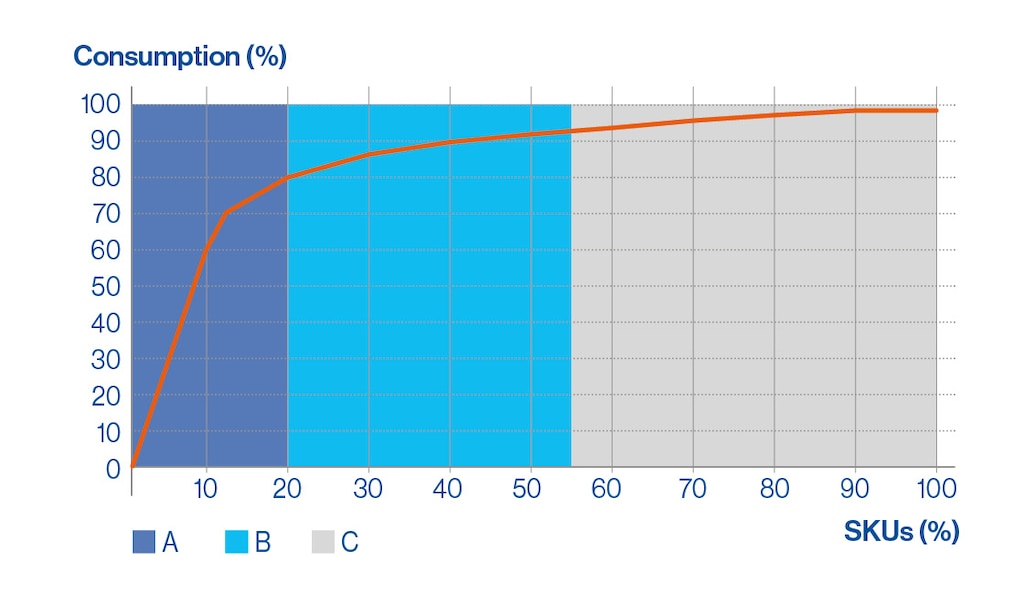
Pareto law: optimising logistics processes with the 80/20 rule
The Pareto law is based on the idea that a small set of factors or elements typically accounts for the majority of outcomes observed.
When applied to the warehouse ecosystem, particularly stock management, the Pareto law (aka the Pareto 80/20 rule) indicates that 20% of inventory generates 80% of revenue.
What is the Pareto law?
The Pareto law is a socio-economic concept formulated by the Italian economist Vilfredo Pareto in the late 19th century. The rule suggests that in many situations, approximately 80% of consequences come from 20% of causes. In other words, a small proportion of causes produces the most outcomes.
Pareto first observed this relationship in the distribution of wealth in society, where about 20% of the population possessed around 80% of the economic resources. However, over time, this principle has been applied to a wide variety of areas, including business, economics, logistics, science and technology.
The Pareto law has proven to be a useful tool for prioritising efforts and resources in decisive areas — e.g., logistics — that have a more substantial impact than others. While the 80/20 ratio is a common rule of thumb, it may vary and might not always be that exact.
What are the benefits of Pareto’s law in logistics?
Pareto’s rule can help you identify and focus on the fundamental aspects of your logistics operations.
- Resource prioritisation: identifying which products, customers, or activities are responsible for 80% of your bottom line enables you to allocate resources, time and effort in line with their real impact.
- Inventory optimisation: a small portion of products often generates a significant share of sales. By concentrating on these key items, you’ll manage your inventory levels better and avoid overstocking slow-moving products.
- Efficiency improvement: understanding the primary sources of inefficiencies in your supply chain will allow you to put in place effective measures to address them. These could include route optimisation, lead time minimisation and internal process streamlining.
- Cost reduction: by focusing on the most crucial aspects of logistics, it’s easier to identify areas where you can cut costs without sacrificing service quality, e.g., transport, storage and inventory management.
- Customer service enhancement: recognising which customers generate the largest share of revenue — and thus are more valuable — will help you provide personalised service to meet their needs.
Applied to logistics, the 80/20 law leads to a more efficient allocation of resources, better decision-making and a more agile supply chain.

Pareto law example in warehousing
The 80/20 rule is used in a wide variety of contexts and sectors, including business and warehouse management. One example of how to apply this law to a logistics facility would be through inventory management with the ABC analysis.
Imagine your facility stocks a vast range of products. According to the Pareto law, 80% of your revenue will likely come from 20% of your inventory items. This means that a small group of products are the most popular or higher in demand and, consequently, responsible for the majority of sales.
To apply the Pareto law in warehouse management, your company needs to make sure it stocks enough of the products that make up 20% of your inventory and generate 80% of your profit. This will guarantee that you won’t run out of your high-demand merchandise.
In this case, it’s also advisable to organise products so that your best sellers can be conveniently reached. They should be positioned in high-visibility, easy-access locations in the facility. Likewise, allocating more resources (e.g., time and effort) to handling, packing and shipping the products that account for that vital 20% will help maximise efficiency in order processing.
Applying the ABC analysis using the 80/20 law in inventory management
Rooted in the Pareto principle, the ABC analysis is an inventory management technique used to classify products by their relative importance in terms of value. The three most common criteria for this classification are:
- Inventory value
- Inventory volume
- Movement frequency
Once you’ve categorised your products into three groups (A, B and C) as per their value, you can adopt different management strategies:
- Category A. These items are of the highest value for your business, so they require special attention. It’s important to ensure that these products are always in stock and to maintain strict control over their movements.
- Category B. These goods are of intermediate value. Although they’re less critical than A items, they represent a considerable portion of inventory and have a moderate impact on revenue and costs.
- Category C. This comprises your least valuable products. They make up a small part of your inventory and have a relatively minimal effect on costs and earnings. Feel free to adopt a more relaxed approach with these items. For instance, you can decrease stock levels and you don’t have to track their movements as closely.

Getting the most out of Pareto’s law with a WMS
To establish put away rules in line with the Pareto 80/20 rule, it’s best to use a warehouse management system (WMS). A WMS like Mecalux’s Easy WMS ensures real-time stock control. It also provides precise information on the location of each SKU at any given time.
Through a set of receiving criteria, the WMS software classifies products and applies put away rules defined by the logistics manager. The WMS maximises storage capacity and greatly reduces the time spent on goods movements.
Classifying SKUs according to Pareto’s law saves time and effort in warehousing operations. Looking to optimise inventory locations in your warehouse? Don’t hesitate to contact us. One of our expert consultants will help you scale up your facility’s efficiency.
